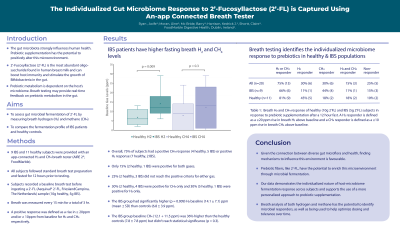Back


Poster Session B - Monday Morning
Category: Functional Bowel Disease
B0272 - The Individualized Gut Microbiome Response to 2’-Fucosyllactose (2’-FL) Captured Using An App-Connected Breath Tester
Monday, October 24, 2022
10:00 AM – 12:00 PM ET
Location: Crown Ballroom

Has Audio

Aine Moran, BSc
FoodMarble
Dublin, Dublin, Ireland
Presenting Author(s)
Aine Moran, BSc1, Aoife Ryan, BSc1, Barry McBride, BEng, MSc1, Kedrick J. Harrison, MPH2, Claire Shortt, BSc, PhD1
1FoodMarble, Dublin, Dublin, Ireland; 2FoodMarble Digestive Health, Ltd., Dublin, Dublin, Ireland
Introduction: The gut microbiota strongly influences our health. Prebiotic supplementation has the potential to positively alter this microenvironment. 2’-Fucosyllactose (2’-FL) is the most abundant oligosaccharide found in human breast milk. Studies have shown that 2’-FL can boost host immunity and stimulate the growth of Bifidobacteria in the gut. However, the metabolism and associated benefits of any prebiotic are heavily dependent on the host’s microbiome. Daily breath testing may provide real-time feedback on whether a particular prebiotic is being metabolized by the host’s microbiome.
Methods: 9 IBS and 11 healthy subjects were provided with an app-connected breath tester (AIRE 2®, FoodMarble) which measures breath hydrogen (H2) and methane (CH4). All subjects followed standard preparation and fasted for 12 hours prior to the test. Subjects recorded a baseline breath test before ingesting a 2’-FL (Aequival® 2’-FL, FrieslandCampina, The Netherlands) sample (10g healthy, 5g IBS). Breath was measured every 15 min for a total of 3 hr. A positive response was defined as a rise in ≥ 20ppm and/or ≥ 10ppm from baseline for H2 and CH4 respectively.
Results: Overall, 75% of subjects had a positive CH4 response (4 healthy, 5 IBS) or positive H2 response (7 healthy, 2 IBS). However, only 15% (2 healthy, 1 IBS) were positive for both gases. Interestingly, 25% (2 healthy, 3 IBS) did not reach the positive criteria for either gas.30% (2 healthy, 4 IBS) were positive for CH4 only and 30% (5 healthy, 1 IBS) were positive for H2 only. The IBS group had significantly higher (p = 0.009) H2 baseline (14.1 ± 7.1 ppm (mean ± SD)) than controls (6.8 ± 3.9 ppm). The IBS group baseline CH4 (12.1 + 11.5 ppm) was 36% higher than the healthy controls (7.8 ± 7.8 ppm) but didn’t reach statistical significance (p = 0.3) Table 1.
Discussion: Given the connection between diverse gut microflora and health, finding mechanisms to influence this environment is favorable. Prebiotic fibers, like 2’-FL, have the potential to enrich this microenvironment through microbial fermentation. However, in order to gain such a health benefit, the prebiotic must be metabolized by the host’s gut microflora. Our data demonstrate the individualized nature of host-microbiome fermentation response across subjects and support the use of a more personalized approach. Daily breath analysis has the potential to identify microbial responders, as well as being used to help optimize dosing and tolerance over time.

Disclosures:
Aine Moran, BSc1, Aoife Ryan, BSc1, Barry McBride, BEng, MSc1, Kedrick J. Harrison, MPH2, Claire Shortt, BSc, PhD1. B0272 - The Individualized Gut Microbiome Response to 2’-Fucosyllactose (2’-FL) Captured Using An App-Connected Breath Tester, ACG 2022 Annual Scientific Meeting Abstracts. Charlotte, NC: American College of Gastroenterology.
1FoodMarble, Dublin, Dublin, Ireland; 2FoodMarble Digestive Health, Ltd., Dublin, Dublin, Ireland
Introduction: The gut microbiota strongly influences our health. Prebiotic supplementation has the potential to positively alter this microenvironment. 2’-Fucosyllactose (2’-FL) is the most abundant oligosaccharide found in human breast milk. Studies have shown that 2’-FL can boost host immunity and stimulate the growth of Bifidobacteria in the gut. However, the metabolism and associated benefits of any prebiotic are heavily dependent on the host’s microbiome. Daily breath testing may provide real-time feedback on whether a particular prebiotic is being metabolized by the host’s microbiome.
Methods: 9 IBS and 11 healthy subjects were provided with an app-connected breath tester (AIRE 2®, FoodMarble) which measures breath hydrogen (H2) and methane (CH4). All subjects followed standard preparation and fasted for 12 hours prior to the test. Subjects recorded a baseline breath test before ingesting a 2’-FL (Aequival® 2’-FL, FrieslandCampina, The Netherlands) sample (10g healthy, 5g IBS). Breath was measured every 15 min for a total of 3 hr. A positive response was defined as a rise in ≥ 20ppm and/or ≥ 10ppm from baseline for H2 and CH4 respectively.
Results: Overall, 75% of subjects had a positive CH4 response (4 healthy, 5 IBS) or positive H2 response (7 healthy, 2 IBS). However, only 15% (2 healthy, 1 IBS) were positive for both gases. Interestingly, 25% (2 healthy, 3 IBS) did not reach the positive criteria for either gas.30% (2 healthy, 4 IBS) were positive for CH4 only and 30% (5 healthy, 1 IBS) were positive for H2 only. The IBS group had significantly higher (p = 0.009) H2 baseline (14.1 ± 7.1 ppm (mean ± SD)) than controls (6.8 ± 3.9 ppm). The IBS group baseline CH4 (12.1 + 11.5 ppm) was 36% higher than the healthy controls (7.8 ± 7.8 ppm) but didn’t reach statistical significance (p = 0.3) Table 1.
Discussion: Given the connection between diverse gut microflora and health, finding mechanisms to influence this environment is favorable. Prebiotic fibers, like 2’-FL, have the potential to enrich this microenvironment through microbial fermentation. However, in order to gain such a health benefit, the prebiotic must be metabolized by the host’s gut microflora. Our data demonstrate the individualized nature of host-microbiome fermentation response across subjects and support the use of a more personalized approach. Daily breath analysis has the potential to identify microbial responders, as well as being used to help optimize dosing and tolerance over time.

Figure: Breath hydrogen and methane response of healthy (10g 2’FL) and IBS (5g 2’FL) subjects in response to prebiotic supplementation after a 12-hour fast. A hydrogen responder is defined as a ≥20 ppm rise in breath hydrogen above baseline and a methane responder is defined as a ≥10 ppm rise in breath methane above baseline.
Disclosures:
Aine Moran: FoodMarble – Employee.
Aoife Ryan: FoodMarble – Employee.
Barry McBride: FoodMarble – Employee.
Kedrick Harrison indicated no relevant financial relationships.
Claire Shortt: FoodMarble – Employee.
Aine Moran, BSc1, Aoife Ryan, BSc1, Barry McBride, BEng, MSc1, Kedrick J. Harrison, MPH2, Claire Shortt, BSc, PhD1. B0272 - The Individualized Gut Microbiome Response to 2’-Fucosyllactose (2’-FL) Captured Using An App-Connected Breath Tester, ACG 2022 Annual Scientific Meeting Abstracts. Charlotte, NC: American College of Gastroenterology.
